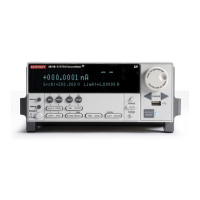2600S-900-01 Rev. C / January 2008 Return to Section Topics B-5
Series 2600 System SourceMeter
®
Instruments User’s Manual Appendix B: Frequently Asked Questions
How do I store measurements in non-volatile memory?
A Series 2600 SourceMeter has two non-volatile buffers for measured readings, source values,
and timestamps: NV Buffer 1 (
nvbuffer1) and NV Buffer 2 (nvbuffer2). Data stored in these
buffers will not be lost when the Series 2600 is turned off.
Reference See Section 7 of the Series 2600 Reference Manual for details on the buffer (data
store).
Front panel operation
See “How do I use the buffer?” on page 1-16 of this manual for details on storing data from the
front panel of the Series 2600.
Remote programming
The following example demonstrates a typical way to use a reading buffer. The commands in the
following steps will perform three SMU A voltage measurements, store them in
nvbuffer1, and
then read the buffer:
Step 1: Clear and configure the buffer
The following command sequence will clear the buffer of all readings, and configure the buffer to
store timestamps and source values:
smua.nvbuffer1.clear()
smua.nvbuffer1.collecttimestamps = 1
smua.nvbuffer1.collectsourcevalues = 1
NOTE Setting collecttimestamps to 0 and collectsourcevalues to 0
will disable the storage of timestamps and source
values.
Step 2: Perform measurements
The following command sequence sets the measure count to three, turns on the output, performs
the three measurements, and then turns off the output:
smua.measure.count = 3
smua.source.output = smua.OUTPUT_ON
smua.measure.v(smua.nvbuffer1)
smua.source.output = smua.OUTPUT_OFF
The three measure readings, timestamps, and source values will be stored in the buffer.
Step 3: Read the buffer
The following code will output the three sets of data (nine values) in the same message:
rb1 = smua.nvbuffer1
printbuffer(1, rb1.n, rb1, rb1.timestamps, rb1.sourcevalues)
For the above printbuffer function, 1 is the starting index for values to output, rb1.n is the
ending index (
n = the number of readings in the buffer, which in this case is 3), rb1 includes the
measured readings,
rb1.timestamps includes the timestamps, and rb1.sourcevalues
includes the source values.

